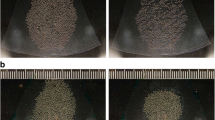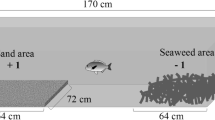Abstract
Increasing concentrations of fluoride in natural bodies of water due to anthropogenic activities can lead to potentially detrimental effects on residing species. Here we investigated the differences in fluoride exposure on feeding behaviour between freshly collected (i.e., wild) and lab-bred Lymnaea stagnalis and if developmental exposure plays a key role in fluoride tolerance. We show that wild snails that reside in naturally fluoridated waters and their fluoride naïve lab-reared progeny have a fluoride tolerance that does not suppress feeding when introduced to a fluoridated food stimulus. These results were also seen in our lab-bred snails who were exposed to artificially fluoridated pond water (at similar concentrations to natural levels) throughout development. However, lab-bred snails that have never been exposed to fluoride, or only exposed during the egg stage demonstrated suppression of feeding in the fluoridated food stimulus condition compared to an unfluoridated food stimulus. Genetic diversity and phenotypic plasticity are suspected to be two key underlying mechanisms for fluoride ion tolerance. These results are critical in understanding how parental and developmental exposure can influence a phenotypic tolerance to a potential chemical pollutant.


Similar content being viewed by others
Change history
15 September 2022
Missing handling editor information updated.
References
Barbier O, Arreola-Mendoza L, Del Razo LM (2010) Molecular mechanisms of fluoride toxicity. Chemico-biol Interact 188(2):319–333
Bijlsma R, Bundgaard J, Van Putten WF (1999) Environmental dependence of inbreeding depression and purging in Drosophila melanogaster. J Evol Biol 12:1125–1137. https://doi.org/10.1046/j.1420-9101.1999.00113.x
Brakefield PM, Frankino WA (2007). In: Whitman DW, Ananthakrishnan TN (eds) Polyphenisms in Lepidoptera: multidisciplinary approaches to studies of evolution. Phenotypic plasticity in insects. Mechanisms and consequences. Science Publishers, Plymouth, UK, pp 121–151
Brown AR, Hosken DJ, Balloux F, Bickley LK, LePage G, Owen SF, Hetheridge MJ and Tyler CR (2009). Genetic variation, inbreeding and chemical exposure—combined effects in wildlife and critical considerations for ecotoxicology. Phil Tran Royal Soc B: Biol Sci 364(1534), pp.3377–3390
Camargo JA (1996) Comparing levels of pollutants in regulated rivers with safe concentrations of pollutants for fishes: a case study. Chemosphere 33: 81–90
Camargo JA (2003) Fluoride toxicity to aquatic organisms: a review. Chemosphere 50(3): 251–264
Canadian Environmental Protection Act (1994) Priority Substances List Supporting Document for Inorganic Fluorides. Prepared by Eco-Health Branch & Environment Canada, Ottawa (Ontario)
City of Calgary (2021) Water treatment report. https://www.calgary.ca/water/drinking-water/fluoride.html. Accessed 4 Dec 2021
Community water fluoride report, Saskatchewan Health Authority, 2020. https://www.caphd.ca › 2020 SK CWF Report- Final
Dalesman S, Lukowiak K (2010) Effect of acute exposure to low environmental calcium on respiration and locomotion in Lymnaea stagnalis (L.). J Exp Biol 213(9):1471–1476
DeSalle R, Amato G (2004) The expansion of conservation genetics. Nat Rev Genet 5:702–712. https://doi.org/10.1038/nrg1425
Eisenreich K, Kelly S, Rowe C (2009) Latent mortality of juvenile snapping turtles from the upper Hudson River, New York, exposed maternally and via the diet to polychlorinated biphenyls (PCBs). Environ Sci Technol 43:6052–6057
Escher BI, Hermens JLM (2002) Modes of action in ecotoxicology: their role in body burdens, species sensitivity, QSARs, and mixture effects. Environ Sci Technol 36:4201–4217
Frankham R (2003) Genetics and conservation biology. C. R. Biol. 326(Suppl. 1):22–29
Fuge R, Andrews MJ (1988) Fluorine in the UK environment. Environ Geochem Health 10: 96–104
Fusco G and Minelli A (2010) Phenotypic plasticity in development and evolution: facts and concepts. Phil Trans Royal Soc B: Biol Sci 365(1540), pp.547–556
Futuyma DJ (1998) Evolutionary biology, 3rd edn. Sunderland, MA: Sinauer Associates
Heagler MG, Newman MC, Mulvey M and Dixon PM (1993) Allozyme genotype in mosquitofish, Gambusia holbrooki, during mercury exposure: Temporal stability, concentration effects and field verification. Environ Toxicol Chem: An International Journal 12(2):385–395
Ito E, Kojima S, Lukowiak K, Sakakibara M (2013) From likes to dislikes: conditioned taste aversion in the great pond snail (Lymnaea stagnalis). Can J Zool 91(6):405–412
Janzen FJ, Phillips PC (2006) Exploring the evolution of environmental sex determination, especially in reptiles. J Evol Biol 19:1775–1784. https://doi.org/10.1111/j.1420-9101.2006.01138.x
Karunagaran VM, Subramanian A (1992) Fluoride pollution in the Uppanar Estuary, Cuddalore, South India. Mar Pollut Bull 24: 515–517
Kovatch CE, Schizas NV, Thomas Chandler G, Coull BC, Quattro JM (2000) Tolerance and genetic relatedness of three meiobenthic copepod populations exposed to sediment-associated contaminant mixtures: role of environmental history. Environ Toxicol Chem 19:912–919
Kristensen TN, Dahlgaard J, Loeschcke V (2003) Effects of inbreeding and environmental stress on fitness—using Drosophila buzzatii as a model organism. Conserv Genet 4:453–465
Lande R, Shannon S (1996) The role of genetic variation in adaptation and population persistence in a changing environment. Evolution 50:434–437
Latif MA, Bodaly RA, Johnston TA, Fudge RJP (2001) Effects of environmental and maternally derived methylmercury on the embryonic and larval stages of walleye (Stizostedion vitreum). Environ Pollut 11:139–148
Linnaeus CV (1758) Systema naturae, vol 1
Metts BS, Buhlmann KA, Scott DE, Tuberville TD, Hopkins WA (2012) Interactive effects of maternal and environmental exposure to coal combustion wastes decrease survival of larval southern toads (Bufo terrestris). Environ Pollut 164:211–218
Meyer J, Di Giulio R (2002) Patterns of heritability of decreased EROD activity and resistance to PCB 126- induced teratogenesis in laboratory-reared offspring of killifish (Fundulus heteroclitus) from a creosote-contaminated site in the Elizabeth River, VA, USA. Mar. Environ Res 54:621–626
Miura T (2005) Developmental regulation of caste-specific characters in social-insect polyphenism. Evol Dev 7:122–129. https://doi.org/10.1111/j.1525-142X.2005.05014.x
Noland LE, Carriker MR (1946) Observations on the biology of the snail Lymnaea stagnalis appressa during twenty generations in laboratory culture. Am Mid Nat 36(2):467–493
Orr MV and Lukowiak K (2008). Electrophysiological and behavioral evidence demonstrating that predator detection alters adaptive behaviors in the snail Lymnaea. J Neurosci 28: 2726–2734
Orr MV, El-Bekai M, Lui M, Watson K and Lukowiak K (2007) Predator detection in Lymnaea stagnalis. J Exp Biol 210: 4150–4158
Palumbi SR (2001) Humans as the world’s greatest evolutionary force. Science 293: 1786–1790
Pickering WF, Slavek J, Waller P (1988) The effect of ion exchange on the solubility of fluoride compounds. Water Air Soil Pollut 39: 323–336
Plautz SC, Salice CJ (2013) Plasticity in offspring contaminant tolerance traits: developmental cadmium exposure trumps parental effects. Ecotoxicology 22: 847–853. https://doi.org/10.1007/s10646-013-1076-7
Rivi V, Batabyal A, Benatti C, Blom JMC, Lukowiak K (2022) Nature versus nurture in heat stress induced learning between inbred and outbred populations of Lymnaea stagnalis. J Therm Biol 103: 103170
Romero-Blanco A, Alonso Á (2022) Laboratory versus wild populations: the importance of population origin in aquatic ecotoxicology. Environ Sci Pollut Res 29:1–11
Roy RL, Campbell PGC, Premont S, Labrie J (2000) Geochemistry and toxicity of aluminium in the Saguenay River, Quebec, Canada, in relation to discharges from an aluminium smelter. Environ Toxicol Chem 19: 2457–2466
Sands M, Nicol S, McMinn A (1998) Fluoride in Antarctic marine crustaceans. Mar Biol 132: 591–598
Swinton C, Swinton E, Shymansky T, Hughes E, Zhang J, Rothwell C, Kakadiya M, Lukowiak K (2019) Configural learning: a higher form of learning in Lymnaea. J Exp Biol 222:jeb190405. https://doi.org/10.1242/jeb.190405
Tatara CP, Mulvey M, Newman MC (1999) Genetic and demographic responses of mosquitofish (Gambusia holbrooki) populations exposed to mercury for multiple generations. Environ Toxicol Chem: An Int J 18(12):2840–2845
Van Straalen N, Timmermans M (2002) Genetic variation in toxicant-stressed populations: an evaluation of the genetic erosion hypothesis. Hum Ecol Risk Assess 8:983–1002. https://doi.org/10.1080/1080_700291905783
Wiley B, Batabyal A, Lukowiak K (2021) Fluoride alters feeding and memory in Lymnaea stagnalis. J Comp Physiol A 208(2):1–11
Zhang H, Xianhao C, Jianming P, Weiping X (1993) Biogeochemistry research of fluoride in Antarctic Ocean. I. The study of fluoride anomaly in krill. Antarctic Res 4: 55–61
Acknowledgements
We would like to thank Dr. Petra Hermann for providing us with the lab-reared population of snails and Iain Philips for collecting the wild strain snails. The current work was supported by funding from the Natural Sciences and Engineering Research Council of Canada [Grant number 227993-2019].
Conflict of interest
The authors have no conflict of interest.
Author information
Authors and Affiliations
Corresponding author
Additional information
Handling editor: Uwe Homberg.
Publisher’s Note
Springer Nature remains neutral with regard to jurisdictional claims in published maps and institutional affiliations.
Rights and permissions
Springer Nature or its licensor holds exclusive rights to this article under a publishing agreement with the author(s) or other rightsholder(s); author self-archiving of the accepted manuscript version of this article is solely governed by the terms of such publishing agreement and applicable law.
About this article
Cite this article
Wiley, B., Batabyal, A. & Lukowiak, K. Fluoride alters feeding in lab-bred pond snails but not in wild snails or their progeny. J Comp Physiol A 208, 537–543 (2022). https://doi.org/10.1007/s00359-022-01563-0
Received:
Revised:
Accepted:
Published:
Issue Date:
DOI: https://doi.org/10.1007/s00359-022-01563-0




